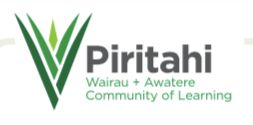
Piritahi Kahui Ako
Achievement Goal Review and
Renewal
2019 - 2021
1
Table of Contents
P2
Member Organisations
P3
Background - Purpose and Vision, Our Journey
P3
Our community
P4
2015-2017 Review and Goal Setting
P4
2017 Review and Reflection of Piritahi
P6
2017 Annual Plan
P7
2017 Theory of Improvement
P9
2017 Theory of Improvement Iteration
P10
2017 Writing Data
P11
2017 Annual Report
P12
2018 Operational Framework
P13
2018 Annual Report
P14
2019 Piritahi ERO Report
P15
2019 Teaching and Learning Framework
P16
Workstreams
P18
2020 Teaching and Learning Framework
P19
2020 Draft Teaching and Learning Framework Iterations
Member Organisations of Piritahi Kahui Ako
Schools
Early Childhood
Blenheim School
ABC Blenheim Central
Bohal y Intermediate
ABC Mayfield
Fairhal School
ABC Springlands
Grovetown School
John St Preschool
Marlborough Boys’ Col ege
Te Kupenga Preschool
Marlborough Girls’ Col ege
Uptown Preschool
Mayfield School
Little Footsteps John St
Rapaura School
Little Footsteps Scott St
Redwoodtown School
Mayfield Kindergarten
Renwick School
PORSE Marlborough
Richmond View School
Redwoodtown Kindergarten
Riverlands School
Renwick Kindergarten
Seddon School
Renwick Preschool
Spring Creek School
Seymour Kindergarten
Springlands School
Springlands Kindergarten
St Mary’s School
Step 2 Growth MarlboroughLtd
Tua Marina School
Witherlea Kindergarten
Wairau Val ey School
Ward School
RTLB
Whitney St School
Witherlea School
NMIT
2
BACKGROUND
Piritahi Kahui Ako was the first kahui ako in NZ to be up and running. It began in 2015 as Blenheim 2BCos -
two communities of schools operating as one in the Blenheim/Marlborough region. As it matured its name
changed to Piritahi - Whiria nga tahi nga akonga - Weave Learners Together to better describe the purpose
and work of the group of learners.
Purpose and Vision
Our initial goal was simple - to bring together our 21 schools and 6 Kindergartens from operating
independently (in some instances in isolation) to work as a col aborative, and create a wider vision for
education in Marlborough - our school of 6000. Our ultimate goal was to raise achievement outcomes for
al students in Marlborough through a success-focussed learning pathway where high quality col aborative
teaching and leadership across the system are the key drivers.
Our Journey
Piritahi is a story of the evolving success and progress of Aotearoa New Zealand’s first, longest serving,
and one of the largest kahui ako. It tel s of how strengthening engagement in col aborative practices across
learning institutions can real y make a difference to leadership capability, teaching practices, and positive
learning outcomes for our students when we al work as one. The story is about the growing and
strengthening of leadership in a context where no real authority exists only influence, but which flourishes
on the strength of col ective agreement, sound research and commitment to purpose. It is a story of growing
the understanding of practice across the sectors - kindergarten, primary and secondary, and about
exploring methodologies that create seamlessness from kindergarten to year 13. It is a story about how a
strong influence on teaching practice can create excel ence in the learning of al students, in particular our
identified priority students.
OUR COMMUNITY
Piritahi is made up of 18 Primary Schools, 3 Col eges, 6 Kindergartens, 18 Early Childhood Centres, and
the RTLB service, and a tertiary provider NMIT (Nelson Marlborough Institute of Technology). Our schools
are diverse - from smal rural schools to 1000 student secondary Col eges, 2 are special character schools,
1 school is transitioning into an area school, and 1 schools has a satel ite bilingual facility. One school is an
Intermediate. Primary student rol s range from 39 to 535.
21% of our students identify as Māori, 5% are Pasifika, 5% Asian, 66% are European Pakeha, and 3% are
identified from other ethnic backgrounds. Our Kahui Ako extends 50 km south of Blenheim, 35km west of
Blenheim, and 15km north of Blenheim. Every school within that zone is a member of Piritahi.
Within our structure we have 7 Across School Lead Teachers and 37 Within School Lead Teachers serving
over 400 teachers. Our Stewardship Group is an elected body of 3 current school board members who
represent our sectors and they provide the governance of Piritahi.
Piritahi has been supported and guided by our Expert Partners Helen Timperley, Anne Hynds, and Linda
Bendikson. The expert partners worked col aboratively with our leadership group to develop our theory of
improvement plan. These were modified to meet the changing needs of Piritahi. They provided guidance
and mentoring to advance the plans.
3
2015-2017 Review and Goal Setting Our first col ection of achievement data in Reading, Writing and Maths for al of our schools was analysed in
2016. It was plain that our first Achievement Goal needed to centre on raising achievement in writing with
focus on the priority groups of Boys, Māori, and Pasifika. Our kahui ako agreed to concentrate on just this
one area, to intensively address and raise the learning achievement for the 3 priority groups.
2017 Review and Reflection of Piritahi We undertook a major 360 degree review in June 2017. This was timely as there was emerging stress with
relational trust, workload, and conflict that Principals had, between their school priorities and the Piritahi
ones. It cleared the air, al owed Principals opportunity to re-set, and reconfirmed commitment from al
schools to the Piritahi principles and plan.
Important points to emerge from the review were:
-
Piritahi showed a strong commitment to the Principles and our Theory of Improvement.
-
Principals were wil ing to share responsibility for the work, if empowered to do so.
-
Work groups were a suitable way to tackle work streams.
-
Relational trust was an area that needed continuous emphasis and care.
-
We needed to do things together, reach for higher levels of col aboration, higher levels of sharing (
especial y around PLD).
-
Clarification of roles and responsibilities - Principals, ASLs, WSLs, and where they fitted with our
Middle and Senior leaders.
-
We needed to consider wel -being in our achievement chal enges.
A fol ow up reflective exercise at the end of the year al owed us another opportunity to measure if there had
been impact from the findings of our May review. The fol owing Principal/ASL voice was helpful …. and
stimulating.
Excerpts from Piritahi Principals Hui Nov 2017
1.Reflection on where we are at as a CoL – How is it going?
-
Need to continue with across school moderation in the future
-
Need more access to whole days were we can al get together. Ideal y one day a term teacher only
days. Need to approach MOE. Don’t want them added to end of year expectations eg extra days
-
Importance for the wel being of our staff – col aborative teacher-only days are beneficial.
-
What opportunities can be provided for our teachers to use LLP/eAsttle/PACT assessments so they
become confident and conversant in using them beyond moderation.
-
ASL are looking at how their roles impact the CoL and how they need to change.
-
A conversation amongst principals needs to be had around how the ASL wil look in 2018 - need
the opportunity to have this conversation. Less flexibility amongst the ASL in 2018 .
-
Model that has been used to date hasn’t worked for Marlborough Girls’ Col ege (MGC) /Marlborough
Boys’ Col ege (MBC)
-
New system needs to be co-designed
2. PLD 2018 – What does everyone want to happen?
-
PLD hours stil available in 2018. Currently 5 clusters working within CoL, unmanageable to lead a
CoL that is going in 5 different directions
-
NPDL cluster feel that it has made a distinct difference on teacher quality
-
PD provided by Kindy Cluster had a huge impact on teacher practise of those attended – both
Primary and Early Learning
-
Proposed that al schools need to be on the same plan/focus so we become more col aborative as a
CoL
4
-
Need to move to focusing on pedagogy of making effective teachers instead of the context such as
writing.
-
Poutama Pounamu – focuses on wel being on community and helps bring everyone together – this
could be the pedagogy and context that meets the wel being part of our kete. Sense that people
want to continue PLD from 2017 – if we keep these going and we do take on Poutama Pounamu wil
it over load us?
3. AP/DP’s/ Middle leaders.
-
Need to review our system design so it includes our middle learners more
4. System Design/Redesign
Piritahi has the ability to re-design the system. What is the profile of the students walking out of the new
col ege. How do we from ECE to Year 9 provide a pathway that provides an opportunity for every child in
our community.
Re-design the system transition between kindergarten/ primary/ intermediate/ col ege to advantage boys,
pasifika and maori.
Wonderings - a col ection of shared thoughts about how Piritahi could influence our education system in the
future.
-
No zones for our schools
-
Recruitment and appointment process - the schools with the biggest achievement chal enges are
they getting the best teachers?
-
How do we get a better understanding of the chal enges in each others schools?
-
I want the teacher profession to be wel respected by our community - parent responsibilities
-
Col ective response to our ministry property problems
-
Equity for al our students so why don’t our schools get equity?
-
How do we make Marlborough a teaching destination?
-
How can we involve the industries into our schools. We have the community leaders on board they
are awaiting the direction from schools - co-location is the key
-
How can we build on the digital potential?
-
Kahui ako curriculum skil s based - In authentic context for reading, maths etc.
-
Centralised SMS source of al the data etc that is being generated in our schools.
-
A teaching body fit for purpose working across our 21 schools. ECE, primary, secondary, tertiary.
-
Sharing principals, teachers, BOT’s etc.
5
 Piritahi Kahui Ako Annual Plan 2017
Piritahi Kahui Ako Annual Plan 2017
Whiria nga tahi nga ākonga - Weave Learners together
Vision
We Value
● Learners col aborating for success.
● Relationships - networks of mutual trust
● Highly literate students achieving
● Respect - for al
across Piritahi
● Achievement - for al
Achievement Chal enge
Our actions
Al learners make expected progress in
● Respond effectively to the needs of al learners.
mathematics, reading and writing.
● Strengthen learner capacity, capability and col ective
efficacy.
Equity - Al priority learners make accelerated
● Foster learner wel being, agency, advocacy and resilience.
progress.
● Raise al student achievement through col aboration and
cultural y responsive practice
Learning
Teaching
Community
Leading
● Identify priority
● Consistent
● Promotion of effective
Develop leadership
learners
moderation practices
teaching and learning to
capability in evaluation,
● Baseline data is
using LLP’s and
Piritahi community
inquiry, and system
col ected by the end of
PaCT embedded
● Engagement with
design to enable
week 4 Term 1 and
across Piritahi
whānau and aiga
creativity and innovation
then again in term 4.
● Define effective
● Engagement with our
● Progress is col ated,
practices across
business community and Continue to grow effective,
analysed and
Piritahi with links to
agencies.
col aborative, and trusting
reported.
cultural
relationships
competencies/pedag
ogies
Define contextual roles and
● Spirals of Inquiry
responsibilities
embedded across
Piritahi
6
 THEORY OF IMPROVEMENT 2017
THEORY OF IMPROVEMENT 2017
Our 2017 Theory of Improvement was a col aborative process of identifying our key strategies, creating
col aborative inquiry teams, and beginning the work. This Theory of Improvement was our action plan
intended for the next 2 years. This was developed col aboratively with our expert partners.
ACHIEVEMENT CHALLENGE: WRITING
Key:
-
Blue Strand - accelerating writing Achievement.
-
Purple strand - Creating community support and involvement.
-
Orange Strand - Developing effective assessment and moderation practices.
-
Green Strand - Strengthening parent/whanau/aiga/school col aboration.
-
Light Blue Strand - Developing effective spirals of inquiry.
-
Brown Strand - Increasing leadership capability and capacity.
AIterations fol owed as the work progressed, and as the strategies were achieved or shifted we uncovered
other priorities. Some key concerns developed around the reliability of the data we were col ecting - even
though there had been agreement on what data was needed there were obvious inconsistencies in the
col ection of data and the moderation of writing across schools. This precipitated an iteration of the Theory
of Improvement with a focus goal “Across Piritahi Kahui Ako we have trusted data to inform teaching
practice and achieve equitable outcomes for al students.”
7
Some critical actions took place around developing consistent understandings of the elements of effective
teaching of writing, consistent moderation of writing, including the consistent use of agreed moderation and
assessment tools. Principals, and then teachers undertook school-wide, col aborative activities to seek
agreement on consistent moderation around the key transition points. These sessions were led by our
ASLs. Our WSLs attended workshops run by our ASLs to share the quality practices they were observing in
schools.
8
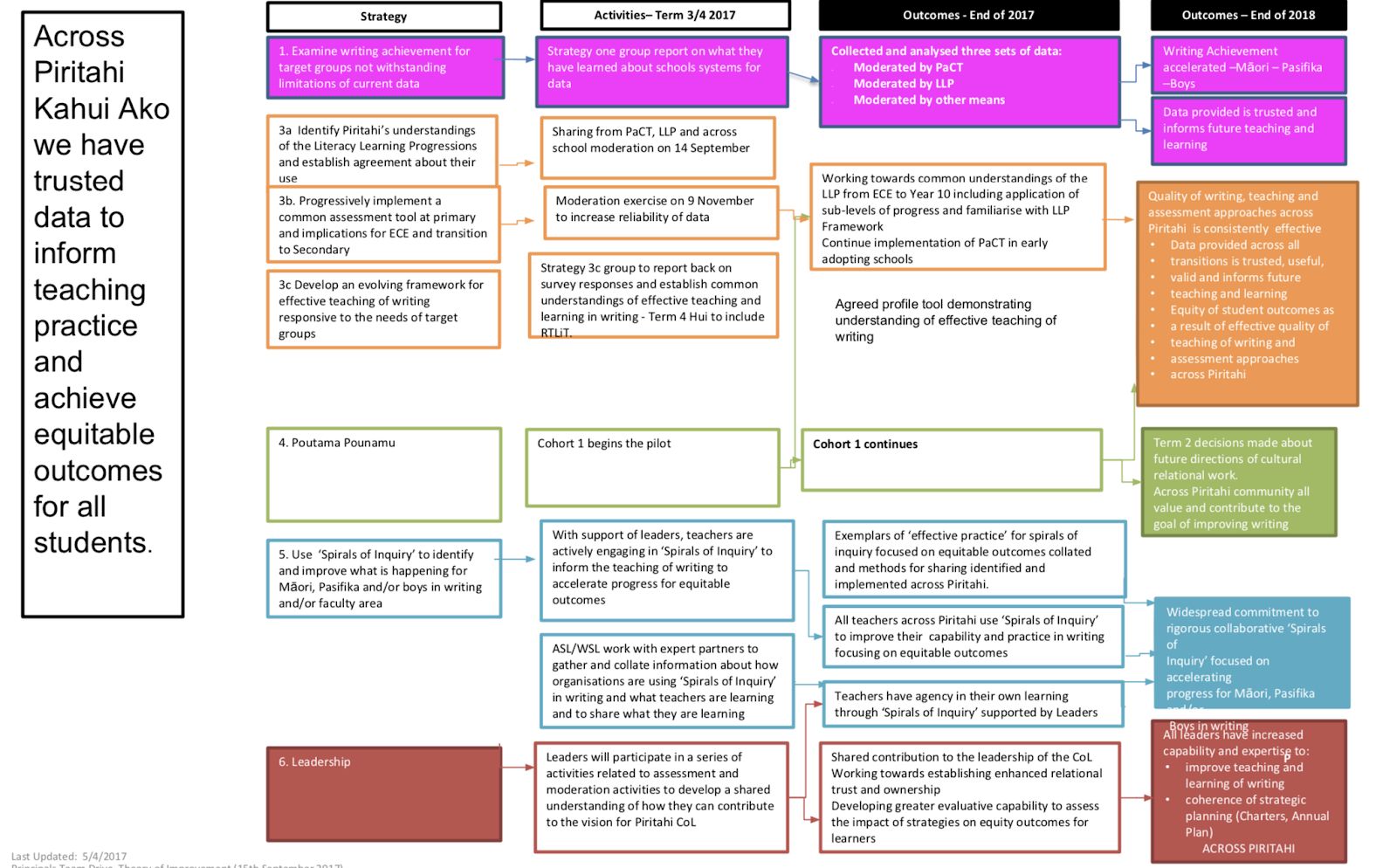 Theory of Improvement Iteration July 2017
Theory of Improvement Iteration July 2017
An iteration of our Theory of Improvement in July reflected:
a) Our progress
b) Our need to simplify as we were being overwhelmed by the complexity of the work
c) Our need to develop trusted, reliable data to inform our progress more accurately
-
A data working party, and another team that were working on developing effective literacy practices
for teaching writing were creating useful tools to support our goals.
-
Professional development in Cultural Responsive and Relational Pedagogies (Poutama Pounamu)
had begun for our first cohort of 5 primary schools and 6 kindergartens. We had the benefit of
knowledge and leadership from within our two Col eges which had several years experience in this
work.
-
Al teachers had identified a group of 4 priority students and were conducting spirals of inquiry
around their learning.
-
Principals and leaders had an in-depth review of their progress and out of this came elevated
commitment to the kahui ako work.
9
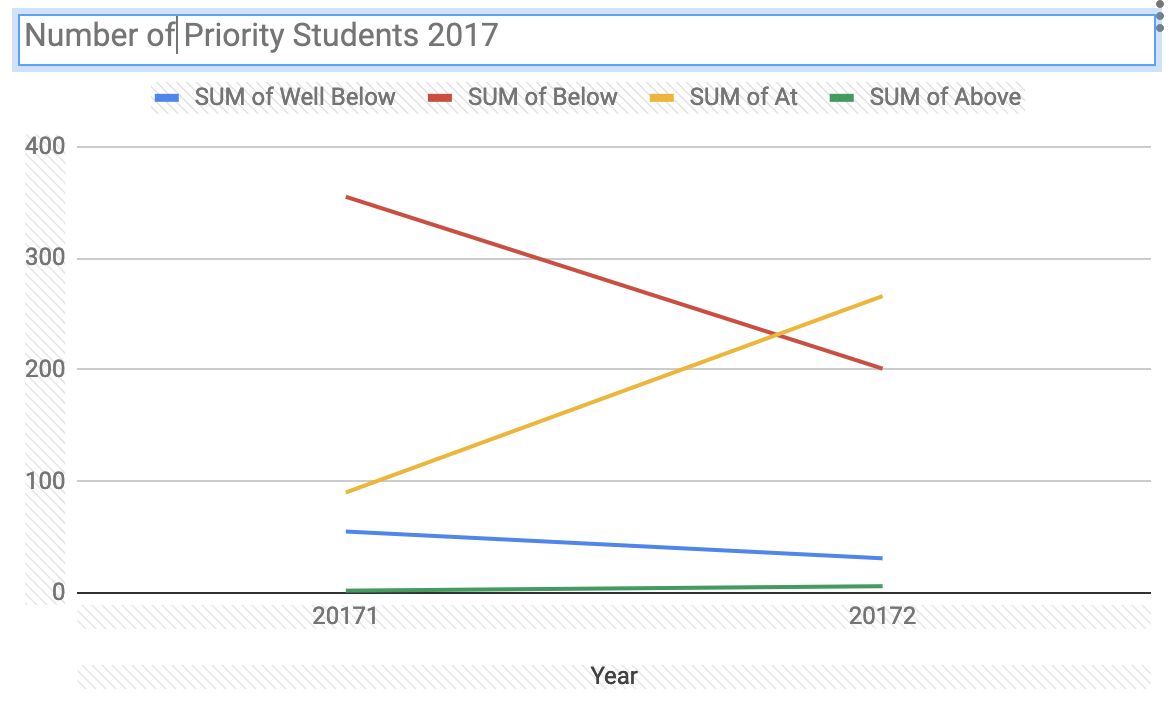 DATA - Writing 2017
DATA - Writing 2017
By the end of 2017 we had greater confidence in our data, but yet we stil needed to persist with col ection
of trusted data for 2018 and beyond. Our writing data for priority students showed impressive acceleration
of achievement - a factor we put down to increasingly rigorous spirals of inquiry around our identified priority
learners.
Shifts in Achievement of our priority students in 2017 - 37% or 185 out of 504 students made accelerated
progress.
10
 PIRITAHI KAHUI AKO ANNUAL REPORT 2017
PIRITAHI KAHUI AKO ANNUAL REPORT 2017
This annual report was presented to Boards of Trustees and our Piritahi community at a public meeting at
the start of 2018. The report highlighted the outcomes achieved from the work undertaken from our Theory
of Improvement with the gains in achievement made by students at the centre…. most notably our priority
group of learners.
11
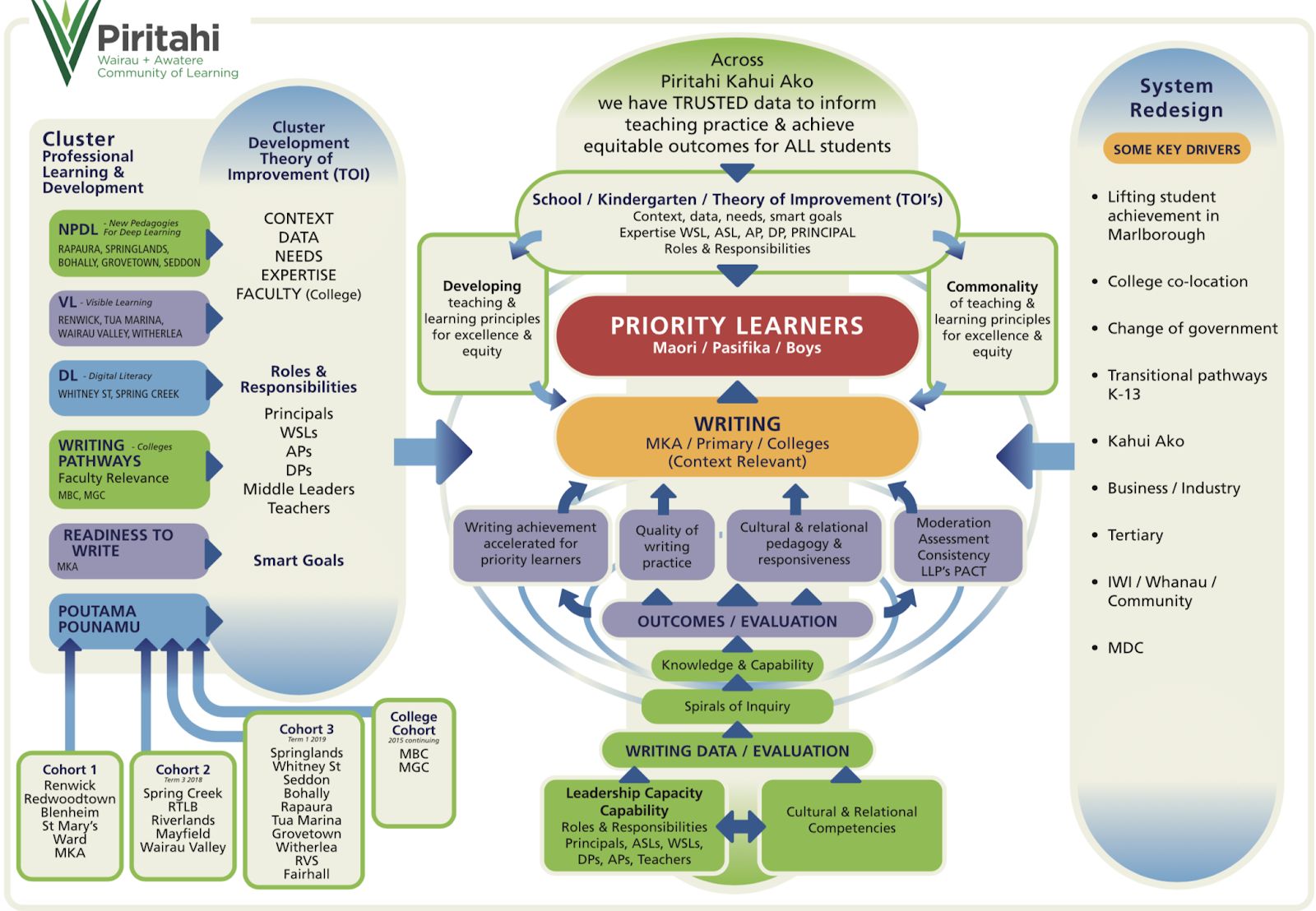 2018
2018
To start the 2018 year an Operational Framework was developed to clarify the Piritahi work focus and place
this in a framework that enabled Principals to feel less conflicted about involving their staff and communities
in growth and development beyond the Piritahi goals. This was an important step in re-emphasising our
commitment to our common goals, directing the Piritahi work, clarifying where school and cluster PLD fitted
in the Piritahi structure and strengthening relational trust. The lead principals met staff in their schools to
discuss the intent and benefits of the framework.
PIRITAHI OPERATIONAL FRAMEWORK 2018
The core work of Piritahi was established at the centre of the model, while the influencers on our work sat to
the side. Schools developed a theory of improvement that established the links between the in-school and
Piritahi work with conduits to sharing successful strategies and interventions.
Cross school moderation, PLD, and leadership capacity building were outcomes to feature in the 2018 year.
Two new cohorts were immersed with Cultural Relational and Responsive Pedagogy delivered by Poutama
Pounamu, supported by and supporting the two Col eges which had begun this work prior to Piritahi. The
third and final group began this work in 2019. The New Pedagogies for Deeper Learning PLD cluster
developed strong learning relationships across their schools and began Cultural Relational and Responsive
Pedagogy through their provider. In 2019, to utilise the special strengths of our expert partner, we
addressed the workstream around building leadership and teaching capacity with a series of PLD sessions
for our Principals, ASLs and Middle Leaders.
In September 2018, after useful PLD at the National Kahui Ako hui in Wel ington and the top of the south
Kahui Ako Principals’ hui in Motueka, Piritahi began an extensive review of their achievement goals and
12

their needs for goals in other aspects of learning, especial y wel -being. A wide selection of principals, ASLs,
WSLs, Senior and Middle leaders, Kindergarten representatives, and RTLB contributed to the initial review.
A working group distil ed the responses and identified the key priorities. A draft framework was distributed to
school Principals, Boards of Trustees and community leaders for consultation. Boards fed-back positively
on the framework and Piritahi’s work. After further refining the 2019 Piritahi Teaching and Learning
Framework was approved.
Piritahi co-lead Principals attended Board meetings to explain the new framework, listen for opinions and
answer questions.
Piritahi responded to the offer of a change manager to provide guidance on how we can more effectively
engage with, and develop our relationships with our 8 iwi. This began by establishing relationships and
understandings at the level of the community’s new bi-lingual satel ite Pa Wananga, which is attached to
Renwick School. The learnings from this work are being applied to the framework work-stream around
community, iwi and Māori engagement.
PIRITAHI KAHUI AKO ANNUAL REPORT FOR 2018
Key Points:
1. 42% (235) of our priority learners accelerated their achievement in writing
2. There was a much higher confidence in the consistency of writing moderation across the Kahui Ako,
and therefore a higher level of trust in what the data was tel ing us.
3. The impact being made on our priority learners was not significantly carried over to similar impact on
other learners - an area for deeper examination.
13

Principals and senior leaders col aboratively develop the new Framework
PIRITAHI ERO REPORT (2019)
Common strengths include:
-
a focus on effective teaching and building teacher capacity to respond to students’ needs
-
a col aborative, col egial culture professional, improvement focused leadership/effective change
management
-
a broad, rich meaningful curriculum - child responsive in kindergartens
-
cultural y responsive curriculum
-
clear, active vision and values
-
positive relationships with whānau
-
partnerships for learning with whānau
-
useful transition processes (kindergarten to school)
-
a focus of children’s wel being – kindergartens
Common areas for improvement include:
-
raising student achievement in literacy and/or mathematics
-
improving internal evaluation practices
-
increasing cultural responsiveness
-
strengthening stewardship
-
deeper inquiry into the effectiveness of teaching
-
strengthening assessment, planning and evaluation practices – kindergartens
14
 2019 Teaching and Learning Framework
2019 Teaching and Learning Framework
The 2019 Teaching and Learning Framework clearly defined the 4 main work streams. Our schools and
kindergartens have committed to these through their own strategic plans. At the centre always are our
learners.
Of special satisfaction has been the extent to which Principals and Head Teachers have embedded the
framework into their workplace charters and strategic plans. Without any doubt we can confidently state that
every learning centre in Piritahi is ful y integrating the work of Piritahi in to the work of their schools - in a
manner that is relevant to their context, authentic to their priorities, articulated across teaching staff and al
Piritahi members.
Our overarching expectation is - In learning environments that drive towards Equity, Excel ence and
Belonging, through the application of Cultural y Relational and Responsive Pedagogies, and with genuine
col aboration across al of Piritahi, al learners wil make expected progress and al of our priority learners
wil make accelerated progress.
15
2019 Workstreams
We have applied 4 workstreams to help us achieve the Teaching and Learning Framework:
1. Strengthening Teacher/Leadership Capability
We wil implement strategies to strengthen teacher and leadership capability to improve student outcomes:
-
Deepen col aborative practice using spirals of inquiry, that leads to student acceleration in progress,
and improvement of teacher practice.
-
Strengthen teacher and leader capacity through effective PLD, and sharing quality practices
including Poutama Pounamu, New Pedagogies for Deep Learning, Leading Adult Learning.
-
Develop and implement Piritahi effective teaching practices/assessment/cultural y responsive
practices.
-
Every teacher identify 4 priorities students and conducts a spiral of inquiry around accelerating their
progress.
-
Share effective, successful practices across Piritahi.
Evidence of progress:
Current state Term 4 2019: Quality of teachers’ Spirals of Inquiries is inconsistent - some high quality
models are shared across the kahui ako. Focus on 4 priority students has enabled acceleration of these
students, but not yet showing an associated improvement in achievement of al students. Exploration
continues in to why this is.
Professional Development is having a positive influence on teacher practice and school curriculum. Piritahi
has yet to develop effective evaluative processes to evidence the extent of PLD on teacher practice and
student improvement.
Effective practices are being shared each term across Piritahi - our ASL team organises and promotes this,
feedback from schools and centres has been positive.
Smart Goals
-
Extend effective teacher moderation practices.
-
Develop writing best practice indicators.
-
Al teachers to use spirals of inquiry to reflect on their teaching and learning practices.
2. Hauora
We wil implement strategies to improve student wel -being which wil be reflected in improved engagement,
attendance and achievement:
Current state: Piritahi definitions of Equity, Excel ence and Belonging have been agreed. They now need to
be embedded in school practice. Working on an agreed understanding of Mauri ora and how this is
developed in our schools and centres.
Al schools have registered for Education Counts - we wil use this data to set priorities and strategies going
forward, including engaging with appropriate agencies.Develop and apply agreed understandings of Mauri
Ora, Equity, Excel ence and Belonging.
16
Smart Goals
-
Analyse a range of data to create a clear picture of the factors in schools that affect student hauora
and therefore achievement and progress.
-
Develop strategies that can be applied across al sectors to address significant hauora factors.
-
Engage with agencies to support effective outcomes around our hauora priorities.
3. Monitoring and Evaluating Progress
We wil strengthen our monitoring and evaluation processes to achieve consistency and confidence in our
student achievement data:
Current State: There is greater consistency in teachers’ moderation of writing across Piritahi. Our
approaches leading to this improvement wil now be extended to maths and reading.
A range of assessment and moderation tools are being used, with the emphasis being on consistency.
Piritahi has developed a schedule of achievement and progress expectations. Data from this wil provide
valuable data on student progress and achievement levels across a range of fields in Reading, Writing and
Mathematics in 2019. In 2020 the chal enge wil be to analyse and address the findings. We wil report in
terms of both progress and achievement in line with our achievement expectations in 2020 and 2021, and
wil have a body of comparative data to measure impact.
Smart Goals
-
Use consistent assessment practices and tools.
-
Measure the progress of al students and the impact across Piritahi fol owing agreed requirements.
-
Accelerate the progress of Target/SOI students for Reading, Writing and Maths.
4. Community, Iwi, and Māori Engagement
We wil design and apply cultural y responsive pedagogy and practices to maximise family and whanau
engagement in student learning:
Current state: Our working party has engaged with the Resource Teacher Māori to support us with effective
approaches to develop a Māori Education Strategy.
Some schools are wel advanced with developing their local curriculum.
Piritahi leadership hui open with a local story being shared, and these are posted on our kahui ako website
for the benefit of al schools.
Achieving a Māori Education Strategy development is a target by 2021.
Smart Goals
-
Develop local curriculum in col aboration with iwi and community.
-
Increase engagement with Māori through local curriculum initiatives.
-
Co-create a Māori Education Strategy
-
Strengthen transitions across Piritahi.
17
Monitoring and Measuring Progress - Tools and Sources of Evidence
Writing: Piritahi agreed form of LLPs, PACT, e-asTTle, PAT, STAR, Piritahi developed Achievement
Expectations 2019, NCEA Level 2, Piritahi developed Effective Teaching Indicators for Writing
Hauora: Education Counts data, NZCER Wel being@School survey, School pastoral data, Principal and
Leader voice, MGC attendance project.
Cultural Responsiveness/Community and Iwi Engagement: Classroom Observations and co-inquiry
conversations, Rongohia te Hau
2020 Teaching and Learning Framework
Piritahi leaders are currently developing an updated framework based on the reviewed achievements and
chal enges experienced in 2019. This Framework is likely to have Strengthening Capability, Hauora, and
Community, Iwi, Māori Engagement as workstreams. The goals and actions of the monitoring and
evaluating progress wil be absorbed into these workstreams where most relevant. This Framework is
expected to be approved by the leadership group before the beginning of the 2020 school year.
18
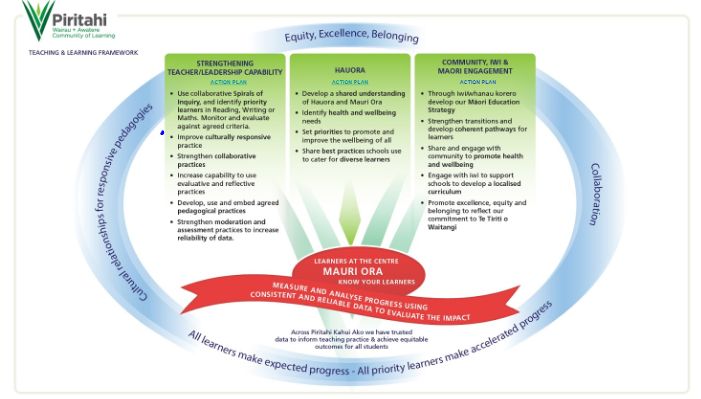
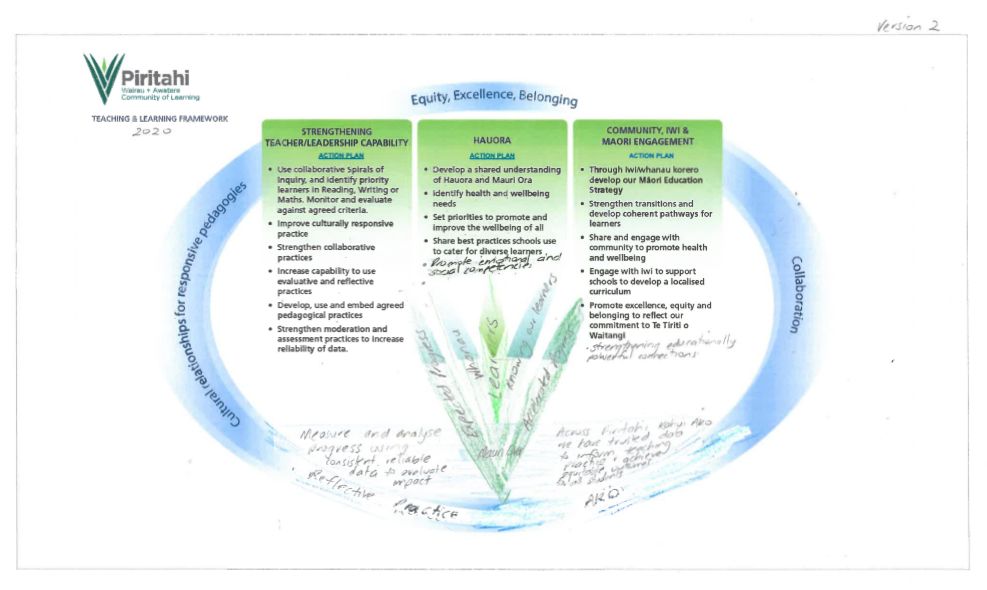 2020 DRAFT Teaching and Learning Framework Iterations
2020 DRAFT Teaching and Learning Framework Iterations
Version 1
Version 2
Murray Hewson, Gaylene Beattie, Cheryl Wadworth (Co-Lead Principals)
19











